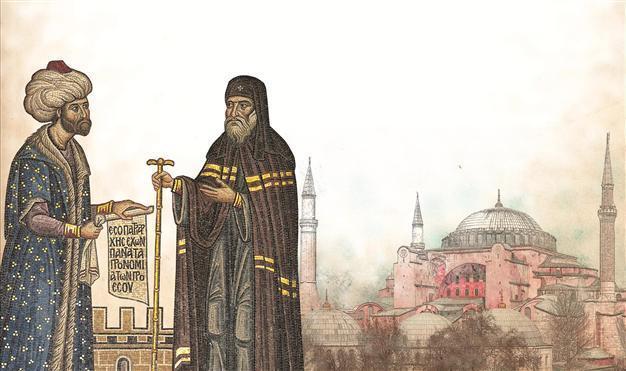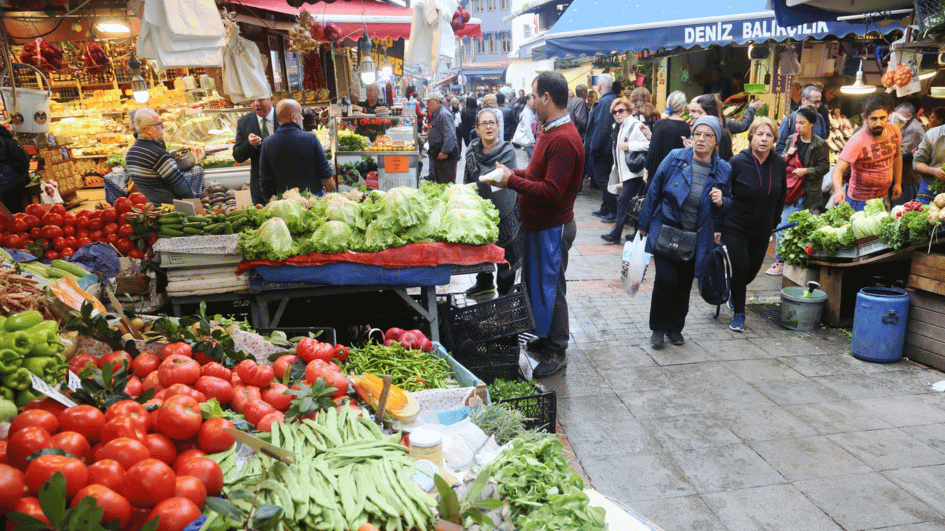The Byzantium that is still with us
NIKI GAMM

A mosaic depicting Fatih Sultan Mehmed handing over a firman (imperial edict) and a staff to Gennadios Scholarios.
“The spider serves as gatekeeper in the halls of Chosroes.The owl calls the watches in the palace of Afrasyab.”
Or so Sultan Mehmed II is supposed to have proclaimed overlooking the city from the roof of the Hagia Sophia following the conquest of Constantinople in 1453.
“And Ruin is fixed on my tower and my wall,
Too hoary to fade, and too massy to fall.”
While Lord Byron penned the lines above about a different place in the 19th century, they equally apply to what he saw during his visit to Istanbul.
Mehmed II found the fabled city of Constantine, New Rome, a city in ruins. But once upon a time it had not been that way. Palaces, mansions and churches decorated the historic peninsula behind the mighty walls that you would have thought would intimidate any potential enemy. But the Arabs weren’t intimidated when they advanced on the city and laid siege to it in the 7th century. Their religious zeal wasn’t enough to overcome a city being resupplied by sea.
Constantinople’s fame continued even as quarrels and coups took place among its rulers with the military involved. So untrustworthy were the Byzantines among themselves that their rulers chose to hire foreigners to make up their personal guards. Conscious of their glorious past, they kept up appearances – thrones that ascended and descended, mechanical lions, pageantry such as the processions of the emperor, and religious ceremonies in hundreds of churches. The golden apple began to rot from within.
The Crusaders who set out for Jerusalem on the Fourth Crusade decided that Constantinople was an easier target and they were right. They entered the city in 1204 and held it until 1261, when the Byzantines were able to reconquer the city. In the meantime they plundered the city and sent boatloads of loot to Italy especially. Constantinople never recovered. More importantly, Muslims who were already entering Anatolia in the form of Seljuk Turks and nomadic Turkish tribes became aware that it was no longer invulnerable. Less than 200 years and several attempts later, the Ottoman Turks finally entered the city.
What would Fatih have seen from the Hagia Sophia? There were the ruins of the Great Palace to the east, the Hippodrome to the south and the palaces and mansions of the members of the imperial family and the wealthy (most probably falling apart), and not much more. The Ottomans built on top of the ruins, repaired the walls and took over many of the Greek Orthodox churches that were still suitable, turning many of them into mosques. That meant a number of Byzantine buildings, in addition to Hagia Sophia and the walls, were able to survive to the present day.

An 18th century depiction of the Church of the Mother
of God (Panaghia
Pammakaristos), the seat of the
Patriarchate from 1456 to 1587.
A number of years ago, two older American women came to Istanbul. They were interested in Byzantine clothing and although they had little expectation of seeing any, to them Istanbul was Constantinople and it was the closest they could get to ancient Byzantium. However, they were advised to attend a ceremony or at least an ordinary service at the Greek Patriarchal Church of St. George in the Fener district. There they would be able to see the traditional clothing worn by the patriarchs and other members of the church hierarchy that has survived to the present day from the Byzantine period. They went there and left satisfied.
The Americans could have used a book published this year by London Editions Turkey Ltd., entitled “The Ecumenical Patriarchate Today: Sacred Greek Orthodox Sites of Istanbul.” In it they would have found a very concise and clear history of the Greek Orthodox Church from its beginnings amid the controversies of the early Christian church. Many of the decisions about doctrine were heatedly debated in Chalcedon, today’s Kadıköy, just across from the historic peninsula on the Asian side of the city.
Out of those debates the Greek Orthodox Church split with the Roman Catholic Church in 1054 and still remains separate in spite of quite recent efforts to bridge the gap. Following the conquest of Constantinople by the Ottoman Turks, Sultan Mehmed II recognized Gennadios Scholaris, the ecumenical patriarch of the time, as the leader of the Orthodox Church, which at the time included the orthodox churches of the east and the Balkans as well as further afield.

The front cover of ‘The Ecumenical Patriarchate Today.’
In the preface to the book, Ecumenical Patriarch Bartholomew writes: “We are pleased to present to the wider community a small selection of the numerous churches and communities, as well as monasteries and shrines that adorn our city [Istanbul] and have functioned uninterruptedly as places of prayer and worship for hundreds of years. We have endeavored to provide a broad, albeit representative array of sacred sites, which naturally complement the magnificent monuments of this multi-cultured city and its multi-layered region.”
The author Dr. John Chryssavgis, an Australian by birth who now lives in the U.S., is an Archdeacon and is part of the Greek Orthodox Archdiocese of America. He has written a number of books on religion and ecology and serves as an advisor to Patriarch Bartholomew on environmental matters. His experience shows in his ability to describe rather complicated doctrinal subjects in terms laymen can understand.
“The Ecumenical Patriarchate Today: Sacred Greek Orthodox Sites of Istanbul” is available at the Greek Orthodox Patriarchate in Fener, at select bookstores such as D&R and Eren, as well as on a number of websites including Amazon.
















